Analysis of Coal Based Power Plant for Exergy Efficiency Improvement
Added on 2022-11-29
49 Pages9944 Words435 Views
Coal-fired power plant 1
ANALYSIS OF COAL BASED POWER PLANT FOR EXERGY EFFICIENCY
IMPROVEMENT
By (name)
Course
Tutor
College
City
Date
ANALYSIS OF COAL BASED POWER PLANT FOR EXERGY EFFICIENCY
IMPROVEMENT
By (name)
Course
Tutor
College
City
Date

Coal-fired power plant 2
Table of Contents
Chapter 1....................................................................................................................................3
Introduction............................................................................................................................3
Chapter 2....................................................................................................................................3
Literature review........................................................................................................................3
The Rankine cycle..................................................................................................................4
Steam power plant based on the Rankine cycle.....................................................................5
Practical plant component characteristics (deviations and efficiencies)................................5
Chapter 3..................................................................................................................................11
Methodology............................................................................................................................11
Plant description...................................................................................................................11
Modelling the plant components..........................................................................................14
Chapter 4..................................................................................................................................17
Results and analysis.................................................................................................................17
Discussion.............................................................................................................................27
Chapter 7..................................................................................................................................28
Conclusions..............................................................................................................................28
References................................................................................................................................28
Table of Contents
Chapter 1....................................................................................................................................3
Introduction............................................................................................................................3
Chapter 2....................................................................................................................................3
Literature review........................................................................................................................3
The Rankine cycle..................................................................................................................4
Steam power plant based on the Rankine cycle.....................................................................5
Practical plant component characteristics (deviations and efficiencies)................................5
Chapter 3..................................................................................................................................11
Methodology............................................................................................................................11
Plant description...................................................................................................................11
Modelling the plant components..........................................................................................14
Chapter 4..................................................................................................................................17
Results and analysis.................................................................................................................17
Discussion.............................................................................................................................27
Chapter 7..................................................................................................................................28
Conclusions..............................................................................................................................28
References................................................................................................................................28
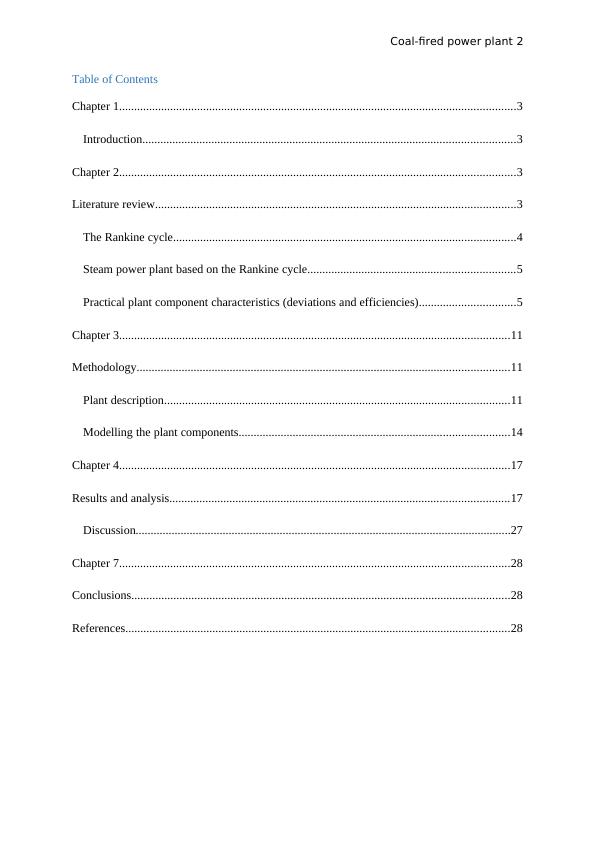
Coal-fired power plant 3
Abstract
This paper presents the energy and exergy analysis of a 350 MW coal-fired power plant.
Exergy and energy analysis have been performed on the major components of a thermal
power plant including the boiler, the high pressure turbine, intermediate and low pressure
turbines, the condenser, feedwater heaters, and water pumps. The results indicate that major
exergy destruction occurs in the boiler which has an exergy efficiency of about 40.4 %.
Besides, the boiler has the highest energy loss hence the lowest efficiency. The condensate
pump has the highest energy efficiency at 98.95 % followed by the high pressure turbine at
93.77 %. The high pressure turbine has the highest exergy efficiency at 92.05 % followed by
the condensate pump at 85.92 %. This study therefore identified the boiler, the low pressure
turbine and the condenser as the major plant components in need of efficiency improvement.
Abstract
This paper presents the energy and exergy analysis of a 350 MW coal-fired power plant.
Exergy and energy analysis have been performed on the major components of a thermal
power plant including the boiler, the high pressure turbine, intermediate and low pressure
turbines, the condenser, feedwater heaters, and water pumps. The results indicate that major
exergy destruction occurs in the boiler which has an exergy efficiency of about 40.4 %.
Besides, the boiler has the highest energy loss hence the lowest efficiency. The condensate
pump has the highest energy efficiency at 98.95 % followed by the high pressure turbine at
93.77 %. The high pressure turbine has the highest exergy efficiency at 92.05 % followed by
the condensate pump at 85.92 %. This study therefore identified the boiler, the low pressure
turbine and the condenser as the major plant components in need of efficiency improvement.
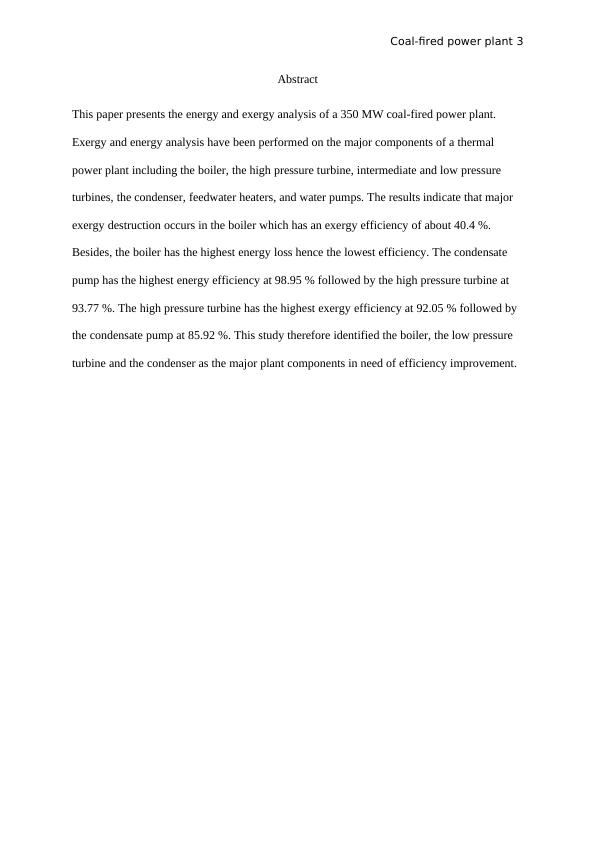
Coal-fired power plant 4
Chapter 1
Introduction
Today, climate change is a major global concern and its impacts are already being
experienced through events such as extreme weather conditions (Mahamud, Khan, Rasul, &
Leinster, 2013). As a result, great emphasis is being placed on the importance of the
development of sustainable environmental practices commonly referred to as sustainable
development. These practices involve reduced consumption of non-renewable energy sources
(fossil fuels) and edging towards sustained consumption of renewable energy sources which
aims to reduce greenhouse gas emissions especially carbon (iv) oxide (Brown & Sovacool,
2011). CO2 emitted from burning fossil fuels was identified as the major contributor to
climate change by the Intergovernmental Panel on Climate Change (IPCC) (IEA, 2015).
Besides, energy security for future generations is paramount and one way to achieve this is
through the improvement of the efficiencies of current energy systems. According to Kumar,
Jilte, Ahmadi, & Kaushal (2019), fossil fuels remain the dominant sources of primary fuels.
Besides, the current rate of exploitation of these fuels cannot be sustained according to
(Kumar, Jilte, Ahmadi, & Kaushal, 2019) leading to a risk of energy crisis in the future.
To ensure continued energy supply far into the future for as long as necessary, the
energy conversion efficiency of power plants must be improved and maintained as high as
possible. High energy efficiency means that for the same level of energy production, less
amount of fuel is utilized (Ludovic, 2014). According to the World Coal Association,
improving the efficiency of a conventional coal powered plant by 1 % reduces CO2 emissions
by about 2 to 3 % (IEA, 2015). Consequently, the cost of electricity falls which is an
attractive venture.
Chapter 1
Introduction
Today, climate change is a major global concern and its impacts are already being
experienced through events such as extreme weather conditions (Mahamud, Khan, Rasul, &
Leinster, 2013). As a result, great emphasis is being placed on the importance of the
development of sustainable environmental practices commonly referred to as sustainable
development. These practices involve reduced consumption of non-renewable energy sources
(fossil fuels) and edging towards sustained consumption of renewable energy sources which
aims to reduce greenhouse gas emissions especially carbon (iv) oxide (Brown & Sovacool,
2011). CO2 emitted from burning fossil fuels was identified as the major contributor to
climate change by the Intergovernmental Panel on Climate Change (IPCC) (IEA, 2015).
Besides, energy security for future generations is paramount and one way to achieve this is
through the improvement of the efficiencies of current energy systems. According to Kumar,
Jilte, Ahmadi, & Kaushal (2019), fossil fuels remain the dominant sources of primary fuels.
Besides, the current rate of exploitation of these fuels cannot be sustained according to
(Kumar, Jilte, Ahmadi, & Kaushal, 2019) leading to a risk of energy crisis in the future.
To ensure continued energy supply far into the future for as long as necessary, the
energy conversion efficiency of power plants must be improved and maintained as high as
possible. High energy efficiency means that for the same level of energy production, less
amount of fuel is utilized (Ludovic, 2014). According to the World Coal Association,
improving the efficiency of a conventional coal powered plant by 1 % reduces CO2 emissions
by about 2 to 3 % (IEA, 2015). Consequently, the cost of electricity falls which is an
attractive venture.
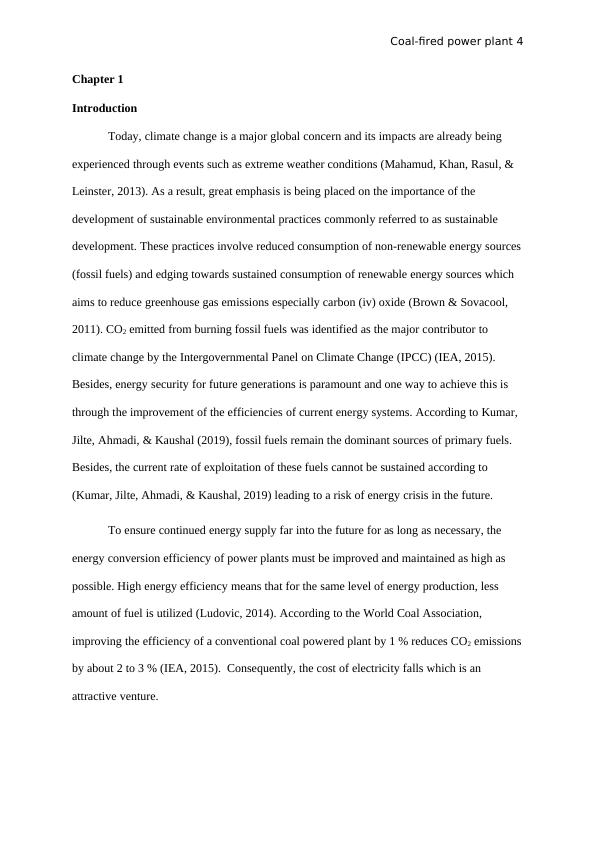
Coal-fired power plant 5
Chapter 2
Literature review
Coal is the largest global source of power (IEA, 2015). Besides, according to IEA
(2015), coal is likely to remain the major source of power far into the foreseeable future due
to its low cost and wide availability. Therefore, there is a need to significantly improve the
efficiency of coal fired plants to ensure that the established sustainable development
objectives are realized. The High Efficiency, Low Emissions (HELE) Coal Fired Power
Generation is an initiative that outlines the steps required for adoption and further
development of technologies to boost the efficiency of coal plants (Zhang, 2019). In order to
generate an equal amount of power, a coal plant with higher efficiency will burn fewer
quantities of coal, emit less carbon (iv) oxide, emit less local pollutants and utilize less water.
Consequently, the carbon footprint of this new plant will be significantly lower compared to
that for a plant operating at a lower efficiency.
Currently, most coal-fired power plants attain a global average efficiency of about 33
%. About three-quarters of these power plants use low efficiency operating methods and have
been operational for over 25 years (Romero & Wang, 2019). HELE technologies have
attained an efficiency of about 45 % with further technological development likely to yield
much higher efficiencies. A combination of HELE technologies with CSS (carbon capture
and storage) is capable of reducing CO2 emissions from coal generation units by about 90 %.
This corresponds to emissions of about 100 g per kWh (Zhang, 2019). Such a plant will
require less operating costs.
Kumar, Jilte, Ahmadi, & Kaushal (2019) showed that exhaust flue gases cause heavy
exergy destruction, accounting for approximately 73.51 % entire boiler subsystem. After
examining various power plants, (Gogoi & Talukdar, 2014) established that the boiler is a
Chapter 2
Literature review
Coal is the largest global source of power (IEA, 2015). Besides, according to IEA
(2015), coal is likely to remain the major source of power far into the foreseeable future due
to its low cost and wide availability. Therefore, there is a need to significantly improve the
efficiency of coal fired plants to ensure that the established sustainable development
objectives are realized. The High Efficiency, Low Emissions (HELE) Coal Fired Power
Generation is an initiative that outlines the steps required for adoption and further
development of technologies to boost the efficiency of coal plants (Zhang, 2019). In order to
generate an equal amount of power, a coal plant with higher efficiency will burn fewer
quantities of coal, emit less carbon (iv) oxide, emit less local pollutants and utilize less water.
Consequently, the carbon footprint of this new plant will be significantly lower compared to
that for a plant operating at a lower efficiency.
Currently, most coal-fired power plants attain a global average efficiency of about 33
%. About three-quarters of these power plants use low efficiency operating methods and have
been operational for over 25 years (Romero & Wang, 2019). HELE technologies have
attained an efficiency of about 45 % with further technological development likely to yield
much higher efficiencies. A combination of HELE technologies with CSS (carbon capture
and storage) is capable of reducing CO2 emissions from coal generation units by about 90 %.
This corresponds to emissions of about 100 g per kWh (Zhang, 2019). Such a plant will
require less operating costs.
Kumar, Jilte, Ahmadi, & Kaushal (2019) showed that exhaust flue gases cause heavy
exergy destruction, accounting for approximately 73.51 % entire boiler subsystem. After
examining various power plants, (Gogoi & Talukdar, 2014) established that the boiler is a
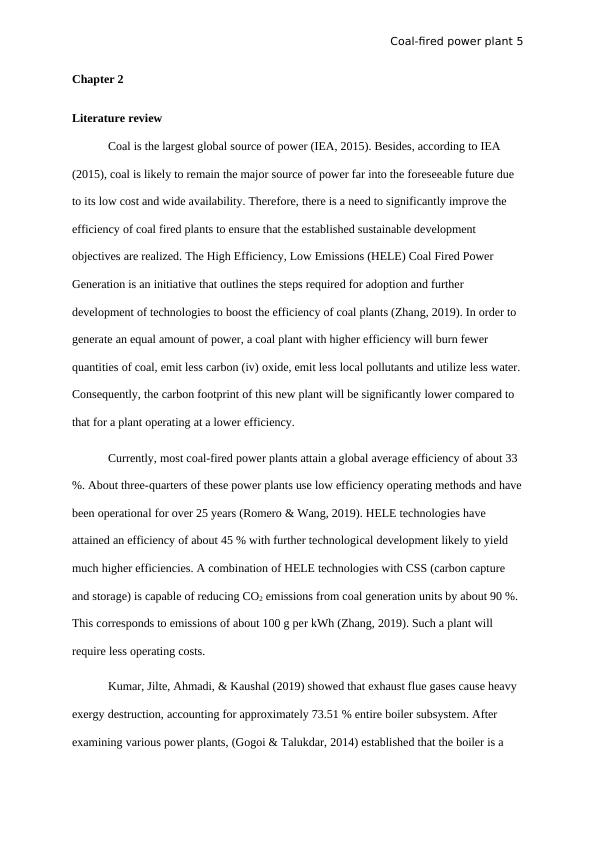
Coal-fired power plant 6
major component in which exergy is destroyed. The cost of steam power plants has been
linked to exergy by many studies (Çetin, 2018). A parametric analysis was conducted by
Gogoi & Talukdar (2014) to establish the effects of changes in pressure inside the boiler and
the rate of fuel flow on the characteristics of a steam plant. The results indicated that these
two variables have a considerable effect on power cycle performance. Another study was
conducted to investigate the effects of changes in other parameters such as the temperature of
the turbine inlet, temperature of the compressor inlet and pressure ratio on CO2 emission and
the overall performance cycle (Zhang, 2019).
Figure 1: Carbon Dioxide Emissions vs. Net Plant Efficiency for a Bituminous coal power
plant
major component in which exergy is destroyed. The cost of steam power plants has been
linked to exergy by many studies (Çetin, 2018). A parametric analysis was conducted by
Gogoi & Talukdar (2014) to establish the effects of changes in pressure inside the boiler and
the rate of fuel flow on the characteristics of a steam plant. The results indicated that these
two variables have a considerable effect on power cycle performance. Another study was
conducted to investigate the effects of changes in other parameters such as the temperature of
the turbine inlet, temperature of the compressor inlet and pressure ratio on CO2 emission and
the overall performance cycle (Zhang, 2019).
Figure 1: Carbon Dioxide Emissions vs. Net Plant Efficiency for a Bituminous coal power
plant
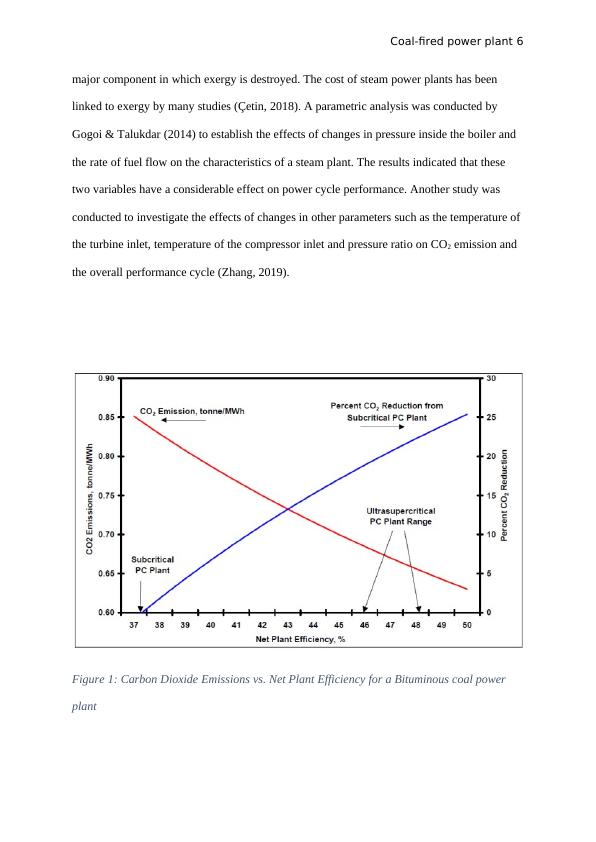
Coal-fired power plant 7
The graph clearly demonstrates the relationship between the efficiency of a power plant and
carbon dioxide emissions. As the net plant efficiency increases, the quantity of CO2 produced
(measured in tonnes/MWh reduces.
The Rankine cycle
The Rankine cycle in four main processes as shown in the figure below (Valencia,
Obregon, & Duarte, 2018). The first stage consists of isentropic expansion where the entropy
of the working fluid is maintained constant. In a thermal power plant, superheated steam (also
called saturated steam) enters the steam turbine at state 1. This is represented by 1 to 2 on the
diagram. This process takes place in the steam turbine. The second stage is isobaric heat
rejection where the pressure of the working fluid is maintained at a constant value. This
process takes place in the condenser and is represented by 2 to 3. The result in this stage is a
saturated liquid at 3. The heat removed from the steam is transferred into the water used for
cooling. The third stage involves isentropic compression where a pumping action performs
external work on the working fluid. This process takes place in the pump and is represented
by 3 to 4 on the diagram. The pump raises the pressure of the saturated liquid to a value
equivalent to the pressure in the boiler. The fourth and last process takes place in the Boiler
or the steam generator. This process involves transferring heat energy from the high-
temperature fuel to the water to generate superheated steam. The whole process is then
repeated over and over for as long as necessary. To restore the pressure of the steam to that in
the boiler in order to maintain the cycle, low-pressure steam exiting the turbine at 2 is
initially transformed into a liquid by the condenser into state 2 and then the pump raises the
pressure to state 4. The process of condensation releases heat. The steam leaving the turbine
is at a temperature and pressure lower than the entrance values as a result of the conversion of
its thermal energy into mechanical energy. The boiler and the condenser can both be
The graph clearly demonstrates the relationship between the efficiency of a power plant and
carbon dioxide emissions. As the net plant efficiency increases, the quantity of CO2 produced
(measured in tonnes/MWh reduces.
The Rankine cycle
The Rankine cycle in four main processes as shown in the figure below (Valencia,
Obregon, & Duarte, 2018). The first stage consists of isentropic expansion where the entropy
of the working fluid is maintained constant. In a thermal power plant, superheated steam (also
called saturated steam) enters the steam turbine at state 1. This is represented by 1 to 2 on the
diagram. This process takes place in the steam turbine. The second stage is isobaric heat
rejection where the pressure of the working fluid is maintained at a constant value. This
process takes place in the condenser and is represented by 2 to 3. The result in this stage is a
saturated liquid at 3. The heat removed from the steam is transferred into the water used for
cooling. The third stage involves isentropic compression where a pumping action performs
external work on the working fluid. This process takes place in the pump and is represented
by 3 to 4 on the diagram. The pump raises the pressure of the saturated liquid to a value
equivalent to the pressure in the boiler. The fourth and last process takes place in the Boiler
or the steam generator. This process involves transferring heat energy from the high-
temperature fuel to the water to generate superheated steam. The whole process is then
repeated over and over for as long as necessary. To restore the pressure of the steam to that in
the boiler in order to maintain the cycle, low-pressure steam exiting the turbine at 2 is
initially transformed into a liquid by the condenser into state 2 and then the pump raises the
pressure to state 4. The process of condensation releases heat. The steam leaving the turbine
is at a temperature and pressure lower than the entrance values as a result of the conversion of
its thermal energy into mechanical energy. The boiler and the condenser can both be

Coal-fired power plant 8
considered as heat exchangers. Both cold and hot fluids flow with minimal heat loss in a
well-designed heat exchanger (Roddy, 2010). As a result, a theoretical consideration is that
the condenser and the boiler have a negligible loss in pressure. Therefore, the Rankine cycle
can be considered to operate between two fixed pressure levels, that is, the pressure in the
condenser and that in the boiler (Tuo, 2012). The turbine lowers the steam pressure while the
pump increases the pressure between the two pressure levels.
Figure 2: Rankine cycle
Compared to the Carnot cycle, the Rankine cycle has a lower thermal efficiency. However,
the cycle has several advantages over the Carnot cycle such as being more economical. It also
presents less operational difficulties (Abbi, 2012).
Steam power plant based on the Rankine cycle
The basic Rankine cycle utilizes steam as the main working fluid. The steam is
generated from the feed water in the boiler by burning fuel (coal for a coal-fired plant). The
steam is produced at high temperature and pressure and carried through pipes to the steam
turbine which converts the steam’s internal energy into mechanical energy to run the electric
alternator. In practice, it is impossible to convert all the steam’s internal energy into
considered as heat exchangers. Both cold and hot fluids flow with minimal heat loss in a
well-designed heat exchanger (Roddy, 2010). As a result, a theoretical consideration is that
the condenser and the boiler have a negligible loss in pressure. Therefore, the Rankine cycle
can be considered to operate between two fixed pressure levels, that is, the pressure in the
condenser and that in the boiler (Tuo, 2012). The turbine lowers the steam pressure while the
pump increases the pressure between the two pressure levels.
Figure 2: Rankine cycle
Compared to the Carnot cycle, the Rankine cycle has a lower thermal efficiency. However,
the cycle has several advantages over the Carnot cycle such as being more economical. It also
presents less operational difficulties (Abbi, 2012).
Steam power plant based on the Rankine cycle
The basic Rankine cycle utilizes steam as the main working fluid. The steam is
generated from the feed water in the boiler by burning fuel (coal for a coal-fired plant). The
steam is produced at high temperature and pressure and carried through pipes to the steam
turbine which converts the steam’s internal energy into mechanical energy to run the electric
alternator. In practice, it is impossible to convert all the steam’s internal energy into
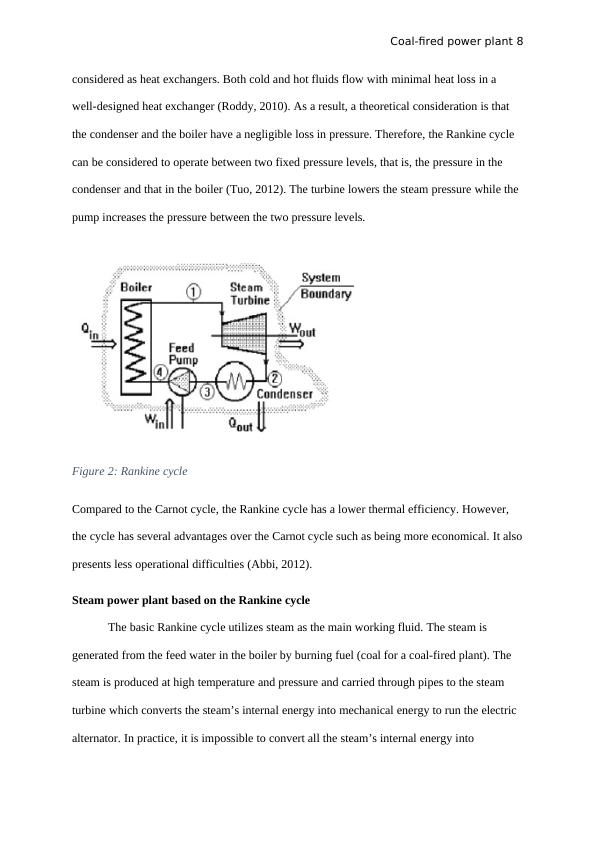
End of preview
Want to access all the pages? Upload your documents or become a member.
Related Documents
Analysis of Organic Rankine Cyclelg...
|6
|2317
|424
Design Of Biomass Power Plant Report 2022lg...
|22
|3333
|46
(PDF) Design and fabrication of pressing steam boilerlg...
|10
|3126
|301
